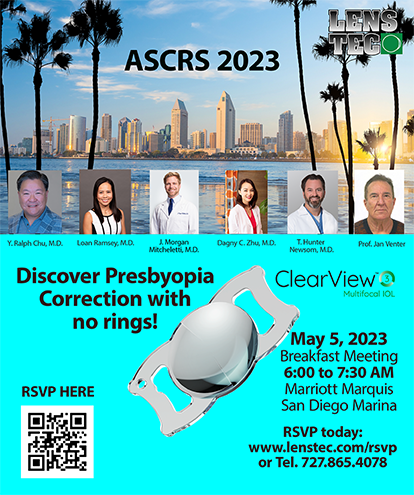Because I am an ophthalmologist who splits his time between clinical work and research, my laboratory is focused on truly translational projects that I hope and believe will have an impact on patients’ lives. Drug delivery is important to me personally. My mother has glaucoma, and when I removed her cataracts a few years ago, she was on six different eye drops with six different dosing schedules during the first few weeks after surgery. My father has diabetic macular edema and has needed periodic intravitreal injections. The current paradigms for treating eye disease—eye drops and injections—are insufficient due to complexity, risk, time, and lack of compliance.
Cataract surgeons often leave chronic eye disease to other subspecialists, but in doing so, the former miss an opportunity. Drug delivery technology has historically been closely tied to retinal specialists (intravitreal devices). Yet, when a cataract is extracted and an IOL is inserted, the peripheral lens capsule becomes “unused real estate.” One of my major research endeavors is to use the lens capsule as a platform for pharmacologic delivery.
My laboratory team and I have developed a bioerodible dexamethasone implant that, in rabbits, suppresses both anterior segment inflammation and, by virtue of its location in the lens capsule, retinal thickening after phacoemulsification. The implant does not affect the IOL’s transparency and may reduce posterior capsular opacification. Together with the emerging protocols for the use of intracameral cefuroxime, vancomycin, or moxifloxacin at the end of a case, I feel we are on the cusp of achieving dropless cataract surgery.
At the other end of the spectrum, patients with diabetic macular edema and age-related macular degeneration often require an indefinite course of intravitreal injections. Although intravitreal injections are the best therapy available at this time, neither the patients (who endure the pain and risk of injection) nor the retinal specialists (whose clinics have become converted into needle assembly lines) are happy with this state of affairs.
One can imagine an implant placed by the anterior segment surgeon into the sulcus once a year that achieves long-term control of vascular endothelial growth factor-induced hyperpermeability and/or neovascularization. This approach would reduce the risk of infection and better control the disease. Getting drug delivery into the hands of anterior segment specialists offers a transformative pathway to the care of patients with chronic eye diseases.
The projects I described are underway in my laboratory. My brother, a retinal specialist, and I have started a spinout company called iVeena to develop them. We welcome the advice and support of anterior segment surgeons and anyone else who is interested to help us move these therapies forward through the FDA’s investigational new drug submission and clinical trial phases. Our ultimate goal is to transform these innovations into products and positively affect patients and practices.
Bala Ambati, MD, PhD, MBA, is a professor of ophthalmology and director of cornea research at the John A. Moran Eye Center of the University of Utah in Salt Lake City. Dr. Ambati is cofounder of iVeena and holds patents related to the technology described herein. Dr. Ambati may be reached at bala.ambati@utah.edu.


